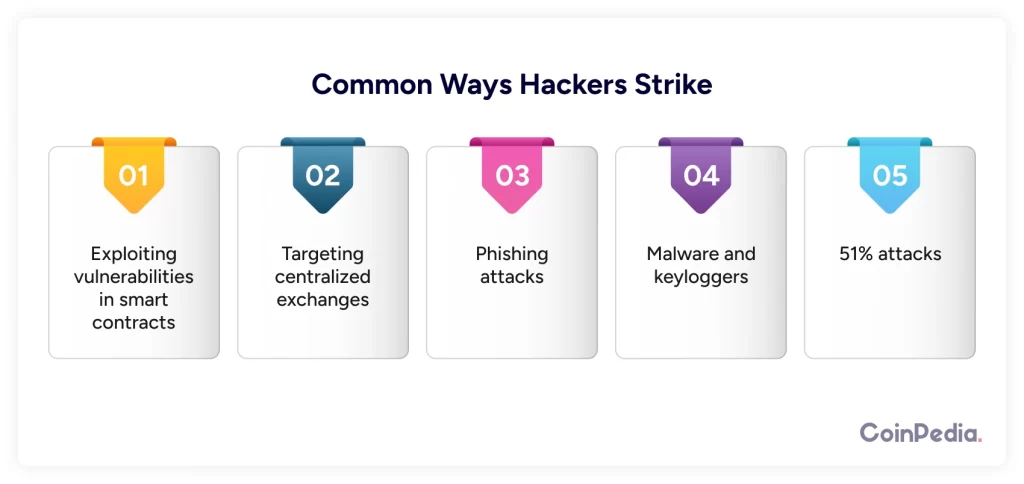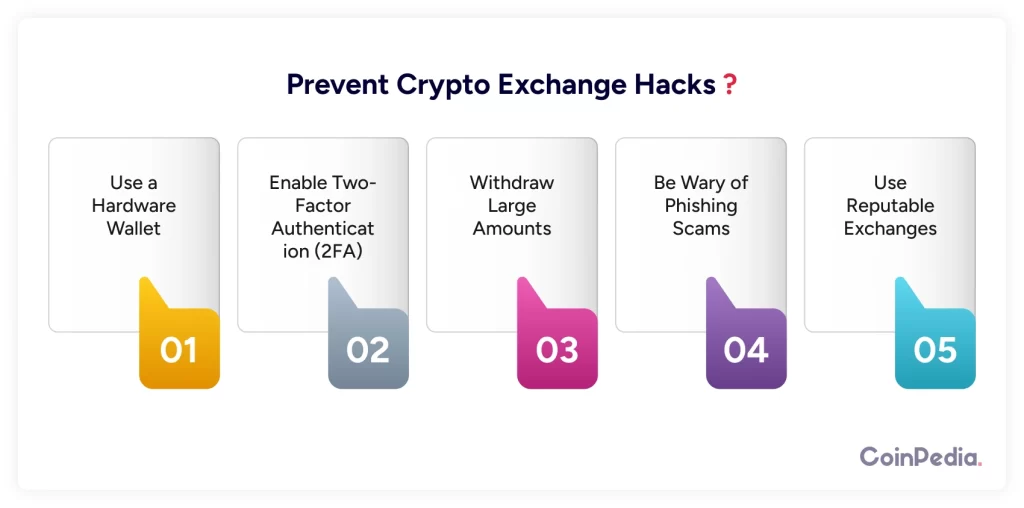
Blockchain is supposed to be one of the most secure technologies out there, right? After all, it’s built on cryptography, decentralization, and transparency. But here’s the reality—blockchain hacks happen all the time. And they can be devastating.
Crypto investors have lost billions due to security breaches, exchange failures, and smart contract vulnerabilities. Even big platforms with tight security measures have fallen victim to hackers.
So, how do these hacks happen? More importantly, how can you protect yourself? Let’s break it down.
How Cryptocurrency Hacks Happen
Before we get into the types of hacks, let’s talk about how they happen in the first place.
Hackers are smart. They don’t just brute-force their way into a system. Instead, they look for weak spots. Maybe it’s a poorly written smart contract. Maybe it’s an exchange with weak security. Maybe it’s an unsuspecting investor clicking on a fake link.
Here are some of the common ways hackers strike:
- Exploiting vulnerabilities in smart contracts – If a smart contract isn’t written well, hackers can manipulate it and drain funds.
- Targeting centralized exchanges – Exchanges hold massive amounts of crypto, making them prime targets for cyberattacks.
- Phishing attacks – A fake website, a misleading email, or a fraudulent wallet can trick users into giving up their private keys.
- Malware and keyloggers – Some hackers install software on a user’s device to steal passwords and access their wallets.
- 51% attacks – If someone gains control of more than half of a blockchain’s mining power, they can manipulate transactions.

Now, let’s break down the five most common blockchain hacks and how they work.
1. Exchange Hacks
Crypto exchanges are like digital banks. They hold millions, sometimes billions, in user funds. This makes them the perfect target for hackers.
One of the most famous exchange hacks was Mt. Gox. Back in 2014, this Japan-based exchange was handling about 70% of all Bitcoin transactions. Then, disaster struck. Hackers stole 850,000 BTC, worth over $450 million at the time (and way more today).
Fast forward to today, and we still see exchange hacks happening. In 2022, FTX collapsed due to mismanagement, and right after, hackers looted $400 million from its wallets.
How to stay safe:
- Don’t keep all your funds on an exchange.
- Use exchanges with strong security features, like cold storage and two-factor authentication.
- Withdraw your assets into a secure wallet (preferably a hardware wallet).
2. Smart Contract Exploits
Smart contracts are self-executing agreements that run on the blockchain. Sounds cool, right? But if there’s a bug in the code, hackers can exploit it.
One of the biggest smart contract hacks was The DAO hack in 2016. The DAO was an Ethereum-based decentralized fund. Unfortunately, its smart contract had a vulnerability that allowed hackers to drain $60 million worth of ETH. This hack was so bad that Ethereum had to fork into two chains: Ethereum (ETH) and Ethereum Classic (ETC).
Another example is the Ronin Network hack (2022), where attackers stole $625 million from Axie Infinity’s blockchain bridge.
How to stay safe:
- Avoid smart contracts that haven’t been audited by security experts.
- Research the projects you invest in.
- Be cautious with DeFi platforms offering extremely high yields.
3. Phishing Attacks
Ever received an email that looks like it’s from Binance, telling you to log in? Be careful—that could be a phishing attack.
Phishing attacks trick users into giving up their private keys or login credentials. They usually happen through:
- Fake emails pretending to be from exchanges or wallets.
- Scam websites that look identical to real ones.
- Malicious browser extensions or mobile apps.
A real-world example? In 2021, a fake Trezor wallet website tricked users into entering their seed phrases. The result? Millions lost.
How to stay safe:
- Never click on links in emails claiming to be from exchanges.
- Always check the URL before entering sensitive info.
- Use hardware wallets and never share your seed phrase.
4. 51% Attacks
A 51% attack happens when someone controls more than 50% of a blockchain’s mining power. This allows them to double-spend coins and reverse transactions, which completely breaks the system’s security.
Bitcoin is safe from 51% attacks because of its massive mining power. But smaller blockchains? Not so much.
One of the biggest 51% attacks happened on Ethereum Classic (ETC) in 2019. Attackers double-spent $1.1 million worth of ETC by controlling the majority of the network’s mining power.
How to stay safe:
- Stick to major, well-established blockchains with strong security.
- Be cautious about investing in smaller proof-of-work cryptocurrencies.
5. Rug Pulls and Exit Scams
Sometimes, the biggest threat isn’t a hacker—it’s the project founders themselves.
A rug pull happens when developers create a new crypto project, hype it up, attract investors, and then disappear with the money.
One of the most infamous examples is Squid Game Token (SQUID). This scam token was inspired by the hit Netflix show. It skyrocketed in value, only for the developers to vanish with $3.3 million overnight. Investors were left with worthless tokens.
How to stay safe:
- Avoid projects that promise quick riches.
- Check if the developers are publicly known and reputable.
- Be skeptical of tokens with low liquidity and no real use case.
How to Prevent Crypto Exchange Hacks?
Exchanges will always be a target for hackers, but that doesn’t mean you have to be a victim. Here’s what you can do to keep your funds safe:
- Use a Hardware Wallet – The best way to secure your crypto is by storing it in an offline hardware wallet like Ledger or Trezor.
- Enable Two-Factor Authentication (2FA) – Always enable 2FA on your exchange accounts. Preferably, use an authentication app instead of SMS.
- Withdraw Large Amounts – If you’re holding a lot of crypto, don’t leave it all on an exchange. Withdraw most of it to a personal wallet.
- Be Wary of Phishing Scams – Never enter your login details on a website unless you’re 100% sure it’s legit.

Use Reputable Exchanges – Stick to well-known exchanges with strong security track records.
Final Thoughts
Crypto is exciting, but it’s also risky. Hackers are always looking for ways to steal funds.
The good news? You don’t have to be their next victim. By understanding how hacks happen and taking the right precautions, you can keep your assets safe.
So, stay alert, do your research, and most importantly—never share your private keys with anyone.
FAQs
Hackers exploit weak security, phishing scams, and exchange vulnerabilities to steal funds. Always use 2FA and store crypto in a hardware wallet.
Never click suspicious links, verify URLs before logging in, and use a hardware wallet to keep your private keys safe from hackers.
Smart contract hacks occur when poorly coded contracts allow attackers to drain funds. Always invest in projects audited by security experts.
Scammers create fake projects, attract investors, then disappear with funds. Avoid tokens with anonymous developers and unrealistic promises.
Well Done! You have now completed the Lesson.
Complete the Quiz and Get Certified! All The Best!
We'd Love to Hear Your Thoughts on This Article!
Was this writing helpful?
 Yes
Yes  No
No
Disclaimer and Risk Warning
The information provided in this content by Coinpedia Academy is for general knowledge and educational purpose only. It is not financial, professional or legal advice, and does not endorse any specific product or service. The organization is not responsible for any losses you may experience. And, Creators own the copyright for images and videos used. If you find any of the contents published inappropriate, please feel free to inform us.



